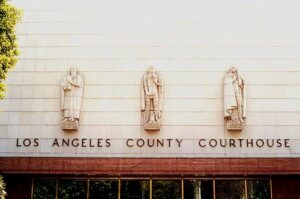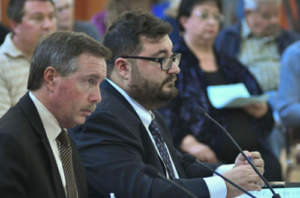No company has met the voting rights act-related demographic needs of more local governments than NDC.
NDC performed analysis of potential California Voting Rights Act liability for over 300 California jurisdictions, and every one of our hundreds of districting and redistricting projects includes compliance with the Federal Voting Rights Act.

The longer you put off receiving the expert assistance you need, the more you risk unnecessary and costly legal disputes. NDC’s analysis will answer your questions regarding compliance with the California and Federal Voting Rights Acts. Our analysis provides you with the informed confidence you need to safely make the right decisions for your community. And NDC’s experience ensures the smooth implementation of any needed changes.
 NDC is the leading demographic expert on the CVRA, having performed demographic assessments of potential CVRA liability for more than 300 California local governments.
NDC is the leading demographic expert on the CVRA, having performed demographic assessments of potential CVRA liability for more than 300 California local governments.
Tulare, Madera Unified, Modesto, the City of Madera, Visalia, Compton, Escondido, Palmdale, San Mateo County, Anaheim and other jurisdictions all came to NDC for assistance when facing CVRA lawsuits. Hundreds of other jurisdictions came to NDC for analysis of potential liability before the plaintiffs appeared.
The 2002 passage of the California Voting Rights Act triggered a “quiet tsunami” of change in local government elections. So far CVRA led to election system changes in:
- 216 school districts
- 34 community college districts
- 137 cities
- 1 County Board of Supervisors (all counties are now by-district)
- 35 water and other special districts
To put the scale of change in context, prior to 2002 only 29 of California’s 482 cities elected Councilmembers by-district. In less than 20 years, that number jumped to over 160. (Numbers last updated May 20, 2020.)
NDC President Douglas Johnson has served as an expert witness or consultant in prominent CRVA cases such as Jauregui v. Palmdale (2013). He has been a speaker on the CVRA at conferences of the California School Board Association, the California Latino School Board Member Association, the California League of Cities, and other state and national conferences on redistricting and the Federal and California Voting Rights Acts.
NDC welcomes the opportunity to assist your jurisdiction with low-cost analysis of potential CVRA liability. Our unmatched experience provides ‘real world’ insights into what plaintiffs claim and how such cases proceed, both in court and in the court of public opinion.
 The California Voting Rights Act, signed into law in 2002, prohibits the use of any election system “that impairs the ability of a protected class to elect candidates of its choice or its ability to influence the outcome of an election.” Jurisdictions can be sued if they elect their governing body using an at-large, from-districts, or mixed election system. If the court finds against a jurisdiction, the jurisdiction must change its election system and pay the plaintiff’s attorneys, experts, and other expenses.
The California Voting Rights Act, signed into law in 2002, prohibits the use of any election system “that impairs the ability of a protected class to elect candidates of its choice or its ability to influence the outcome of an election.” Jurisdictions can be sued if they elect their governing body using an at-large, from-districts, or mixed election system. If the court finds against a jurisdiction, the jurisdiction must change its election system and pay the plaintiff’s attorneys, experts, and other expenses.
California law requires potential plaintiffs to notify jurisdictions of plaintiff’s believe that the jurisdiction is in violation of CVRA and prevents the filing of a lawsuit for a 45-day ‘safe harbor’ period. During those 45 days the jurisdiction must begin the process of moving to by-district elections or risk a lawsuit.
If a jurisdiction begins the process of moving to by-district elections, it has another 90 day “safe harbor” to complete that process.
The 45 days decision time and the 90-day project time are very fast and present numerous challenges. But NDC’s experience with over 300 liability analysis and over 200 completed districting projects prove we can help your jurisdiction get the job done well and on time.
Jurisdictions that fought CVRA claims have paid settlement or judgment amounts ranging from $100,000 to $4.7 million. So far, no jurisdiction has successfully defended itself against a CVRA lawsuit.
 If you answer yes to the following questions, your city may be at risk:
If you answer yes to the following questions, your city may be at risk:
- Does your jurisdiction elect officials “at-large” or “from districts”?
- Do a significant number of “protected class” people (usually Latinos, African-Americans, Asian-Americans, or Native Americans) live in the jurisdiction
- Have there been few minority candidates who run for office?
- If “protected class” candidates have run, did they lose when they ran against non-“protected class” candidates?
Note: A jurisdiction may still be vulnerable even if minority-preferred candidates have been elected under your at-large system.
California law goes well beyond federal law on voting rights issues and results in an expanded number of jurisdictions vulnerable to lawsuits and potentially in violation.
 A proactive analysis of potential liability is a cost effective way to prevent otherwise unexpected lawsuits. Potential liability depends on the demographics of your jurisdiction; the presence of polarized voting; and past voting for or against “protected class” candidates in the jurisdiction and in overlapping jurisdictions (such county and state elections).
A proactive analysis of potential liability is a cost effective way to prevent otherwise unexpected lawsuits. Potential liability depends on the demographics of your jurisdiction; the presence of polarized voting; and past voting for or against “protected class” candidates in the jurisdiction and in overlapping jurisdictions (such county and state elections).
NDC understands the difficult financial situation facing California local governments today. Our approach is efficient and minimizes the expense to our clients. If the initial demographic data makes clear whether or not a District faces liability, our work ends after that initial analysis with only minimal cost.
Only if the answer is not clear from the initial demographic analysis and the jurisdiction has the resources to consider fighting a CVRA challenge do we recommend the more expensive analysis of potential polarized voting in local elections.
In this step by step manner, we ensure that you receive the information needed to make an informed decision in the most cost-effective manner possible. At every step of the process NDC provides background information, puts the data in context, and answers any questions that may arise.
Our analysis will provide you with the confidence and legal protection that arises from using only the most up-to-date information available. There have been recent and significant changes in the old 2005-2009 data provided at the time of the 2011 redistricting.
While CVRA is extremely broad, not every jurisdiction is in violation. NDC will put your analysis in context compared to jurisdictions that have:
- faced lawsuits
- received CVRA challenge letters and moved to by-district elections
- received CVRA challenge letters and not switched (with no lawsuit filed, at least so far)
- not received a CVRA challenge letter so far.
A Poway resident’s federal court challenge against the constitutionality of the CVRA is also pending.
Santa Monica has spent somewhere between $7 million and $10 million on its defense, and plaintiffs requested $22 million in legal fees for the initial trial.
Santa Clara has spent over $1 million on its defense, and plaintiffs were awarded $3 million for the initial trial (though payment is on hold pending the results of the appeal).
- Palmdale: paid plaintiff attorneys $4.7 million (and spent nearly $2 million on its defense)
- Modesto: paid $3 million (and spent nearly $2 million on its defense)
- Highland: $1.3 million
- Anaheim: $1.1 million
- Whittier: $1 million
- Santa Clarita: $600,000
- Santa Barbara: $600,000
- Tulare Hospital: $500,000
- Camarillo: $233,000
- Compton Unified: $200,000
- Madera Unified: about $170,000
- Hanford Joint Union Schools: $118,000
- Merced City: $42,000
Follow the NDC-managed “California Voting Rights Act” Facebook page for the latest CVRA news.





